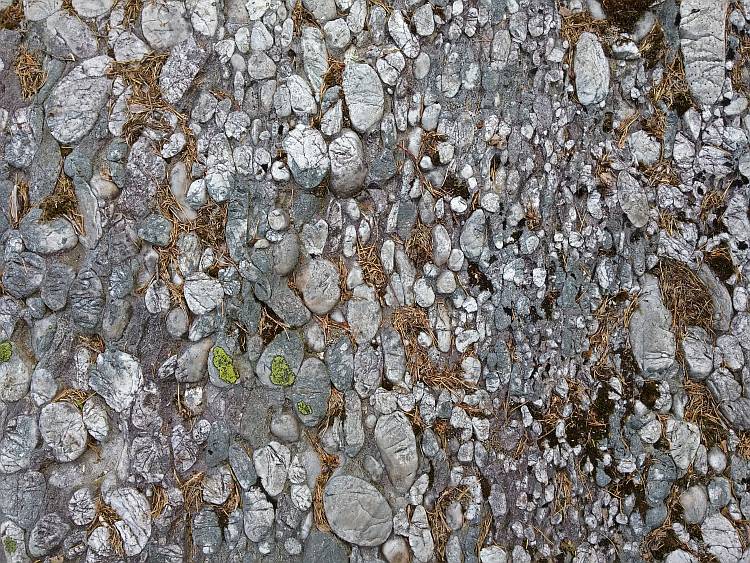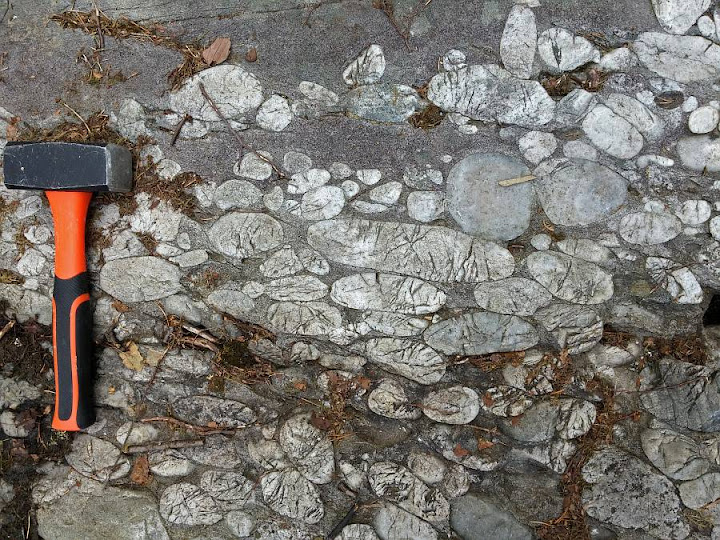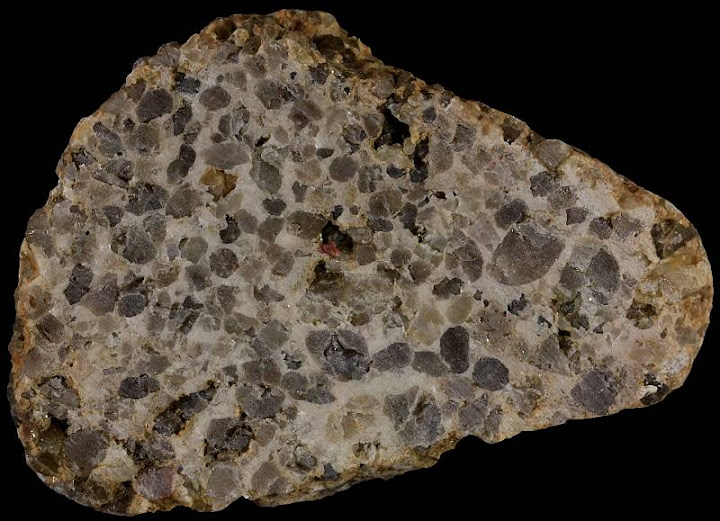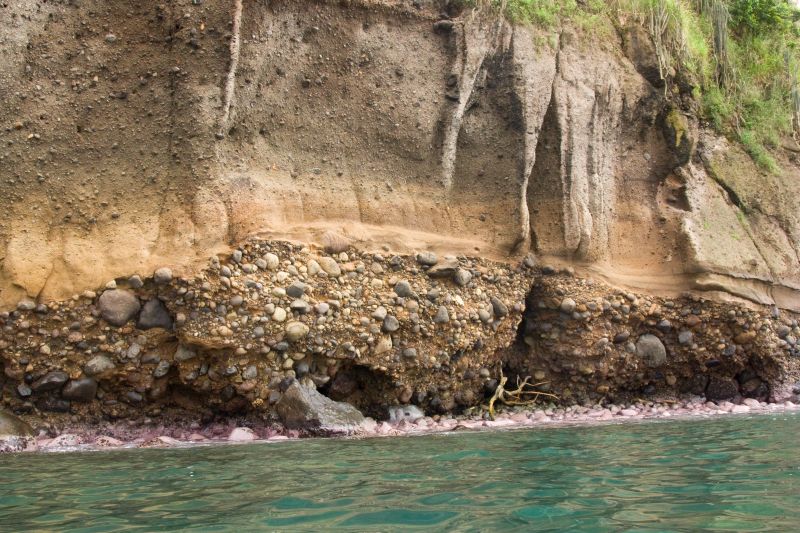Conglomerate is a sedimentary rock formed by the lithification of rounded or sub-rounded gravel (grains larger than 2 mm in diameter). Conglomerate is strongly related to sandstone. It is actually a type of sandstone, although it may not be technically correct to say so. Conglomerate is composed of clasts larger than 2 mm (sand is composed of grains smaller than 2 mm).

An outcrop of quartzite conglomerate. The Bergen Arcs, Norway. Width of view 1.5 m.
Conglomerates are differentiated from sedimentary breccias which are composed of angular clasts. Sometimes it may be difficult to say whether the grains are angular or rounded enough. It is therefore unavoidable that one geologist’s conglomerate will be another’s breccia. I generally prefer to name these rocks conglomerates if there is at least some rounding apparent. Breccia in my opinion is composed of really angular, wedge-like clasts with a strong variation in size. Breccias often show clear signs of shattering which is a result of a sudden and energetic event. Conglomerates tend to be composed somewhat more evenly sized clasts. Conglomerates may be clast-supported (clasts are in contact) or matrix-supported (clasts are separated from one another by fine-grained matrix that binds the clasts together).
There are many different ways to make a conglomerate. Conglomerate deposit may be an ancient riverbed or a coastline. Conglomerates form at the base of mountain ranges or even as a glacial deposit. Tillite is a lithified till (poorly sorted glacial debris) which may be called a matrix-supported conglomerate if there are enough granules, pebbles, cobbles, and boulders present. At least 30% of the rock should be composed of clasts larger than 2 mm in diameter in order to call that rock a true conglomerate.

Conglomerate from the Ordovician near Bergen in Norway. The clasts are made of quartzite and are slightly flattened due to metamorphism.
An outcrop of conglomerate in Cyprus consisting of rounded gabbro clasts from the Troodos ophiolite.
The same outcrop near Kouklia in Cyprus.
Weakly consolidated river deposits in Cyprus, north of Paphos.

Fine-grained conglomerate pebble with quartz clasts and dolomite cement from the northwestern coast of Estonia. Red grain in the middle is almandine garnet.
A boulder of conglomerate on a lithified lahar (volcanic mudflow) at the coast near Portraine in Ireland.
A close-up of the same boulder.
A conglomerate boulder in the Spanish Pyrenees consisting of gray limestone and red sandstone clasts.
Conglomerate is a widespread rock type in northern Spain. These deposits formed as a result of the orogeny (rapidly rising mountains were eroded rapidly as well).
A boulder of conglomerate in southern Ireland (Ballydowane Cove).
Vertical layers of alternating sandstone and conglomerate at Bunmahon Head, Ireland. These layers were originally horizontal.
More sandstone and conglomerate at Bunmahon Head. It is easy to see that original up direction was to the left.
https://picasaweb.google.com/107509377372007544953/2015#6222506386819093746
Conglomerate deposits often give rise to peculiar landforms like this tower in northern Spain.

Conglomerate beneath volcanoclastic rocks. Western Coast of Saint Lucia.
More landforms composed of conglomerate in Spain. Conglomerate is easily erodable. Once there is a crevice formed, it tends to widen which results in many tower-like rock formations.
A closer view of these conglomeratic cliffs.
Hi!
I like this page a lot, i´m currently studying in Spain and I have encountered
a lot of conglomerates while climbing. However, i study geomorphology, for the moment sedimentary rocks
and I have noticed that things differ a lot within the information regarding what is clastic or non clastic.
In my spanish notes conglomerates or “Rudites” are non clastic which i believe is false since every internet page i have been looking at says it is. It is in my opinion however it´s possible that a heavily eroded conglomerate might enter the field of non clastic texture but it would probably still reveal the big clasts and therefore would it not be able to be called non clastic. As i understand, a clastic rock does not have to be sharp edged (coarse surface) since it might have been eroded. A non clastic rock would probably be derived from chemical or biological process that does not show any bigger clasts.
My question would be something like: Can Rudites be both clastic and non clastic and if yes, would it also be applicable to Breccias, conglomerates and puddingstone for example? And what about Sandstone (or other smaller grained similar rocks)?
Sorry for the mess!!
Cheers Robert
I am not sure I understand your question correctly. Sandstone, conglomerate, breccia, rudite, etc. all contain clasts and are therefore by definition clastic rocks.
Well yes but according to notes i have, Rudites can have a texture clastic or non clastic, so you say that´s wrong?
I am afraid I don’t understand what “non-clastic” texture means in this case. “Clastic” literally means that the rock is composed of fragments. This is what rudite is. I can’t imagine how rudite can be non-clastic.
I understand, so would you say that:
Rudites (conglomerates) are clastic?
Arenites (Sandstones) are clastic?
Pelites (Mudstones) are non clastic?
No, they are all clastic. Even mudstones are composed of fragments (clay minerals, silt, iron oxide particles, etc).
Oh ok, what would you consider to be non clastic?
Thanks for the help by the way!
Clastic rocks are sedimentary rocks. Ok, pyroclastic are a complicated case. They are both igneous and sedimentary at the same time. But lava rocks are definitely non-clastic and metamorphic rocks too. Which sedimentary rocks are non-clastic? Well, most limestones are not considered to be clastic rocks although most of them were originally limy mud which is actually composed of tiny fragents but our classification principles are never perfect anyway. Chemical precipitates like evaporites are not considered to be clastic rocks. Clastic rocks are sandstones, mudstones and similar stuff, including conglomerates (rudites).
Hi
My question is> is right name “pebble conglomerate sandstone” or pebble conglomerate is something else and sandstone other? Kindly can you explain to me something related with this!?
Conglomerate is made of pebbles. Pebbles are like sand grains, only much larger. The difference between sandstone and conglomerate is that sandstone is composed of fine sand grains but conglomerate is mostly composed of large pebbles. I hope this answers your question.
Thanks so much for info photos great.Sure answers many of my questions.